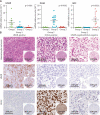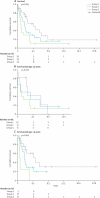Markers of survival and metastatic potential in childhood CNS primitive neuro-ectodermal brain tumours: an integrative genomic analysis
- PMID: 22691720
- PMCID: PMC3615440
- DOI: 10.1016/S1470-2045(12)70257-7
Markers of survival and metastatic potential in childhood CNS primitive neuro-ectodermal brain tumours: an integrative genomic analysis
Abstract
Background: Childhood CNS primitive neuro-ectodermal brain tumours (PNETs) are very aggressive brain tumours for which the molecular features and best treatment approaches are unknown. We assessed a large cohort of these rare tumours to identify molecular markers to enhance clinical management of this disease.
Methods: We obtained 142 primary hemispheric CNS PNET samples from 20 institutions in nine countries and examined transcriptional profiles for a subset of 51 samples and copy number profiles for a subset of 77 samples. We used clustering, gene, and pathway enrichment analyses to identify tumour subgroups and group-specific molecular markers, and applied immunohistochemical and gene-expression analyses to validate and assess the clinical significance of the subgroup markers.
Findings: We identified three molecular subgroups of CNS PNETs that were distinguished by primitive neural (group 1), oligoneural (group 2), and mesenchymal lineage (group 3) gene-expression signatures with differential expression of cell-lineage markers LIN28 and OLIG2. Patients with group 1 tumours were most often female (male:female ratio 0·61 for group 1 vs 1·25 for group 2 and 1·63 for group 3; p=0·043 [group 1 vs groups 2 and 3]), youngest (median age at diagnosis 2·9 years [95% CI 2·4-5·2] for group 1 vs 7·9 years [6·0-9·7] for group 2 and 5·9 years [4·9-7·8] for group 3; p=0·005), and had poorest survival (median survival 0·8 years [95% CI 0·5-1·2] in group 1, 1·8 years [1·4-2·3] in group 2 and 4·3 years [0·8-7·8] in group 3; p=0·019). Patients with group 3 tumours had the highest incidence of metastases at diagnosis (no distant metastasis:metastasis ratio 0·90 for group 3 vs 2·80 for group 1 and 5·67 for group 2; p=0·037).
Interpretation: LIN28 and OLIG2 are promising diagnostic and prognostic molecular markers for CNS PNET that warrant further assessment in prospective clinical trials.
Funding: Canadian Institute of Health Research, Brainchild/SickKids Foundation, and the Samantha Dickson Brain Tumour Trust.
Copyright © 2012 Elsevier Ltd. All rights reserved.
Figures




Comment in
-
CNS PNET molecular subgroups with distinct clinical features.Lancet Oncol. 2012 Aug;13(8):753-4. doi: 10.1016/S1470-2045(12)70260-7. Epub 2012 Jun 11. Lancet Oncol. 2012. PMID: 22691719 No abstract available.
References
-
- Turner CD, Rey-Casserly C, Liptak CC, et al. Late effects of therapy for pediatric brain tumor survivors. J Child Neurol. 2009;24:1455–63. - PubMed
-
- Timmermann B, Kortmann RD, Kuhl J, et al. Role of radiotherapy in supratentorial primitive neuroectodermal tumor in young children: results of the German HIT-SKK87 and HIT-SKK92 trials. J Clin Oncol. 2006;24:1554–60. - PubMed
-
- Pizer BL, Weston CL, Robinson KJ, et al. Analysis of patients with supratentorial primitive neuro-ectodermal tumours entered into the SIOP/UKCCSG PNET 3 study. Eur J Cancer. 2006;42:1120–8. - PubMed
Publication types
MeSH terms
Substances
Grants and funding
LinkOut - more resources
Full Text Sources
Medical
Molecular Biology Databases
Research Materials

